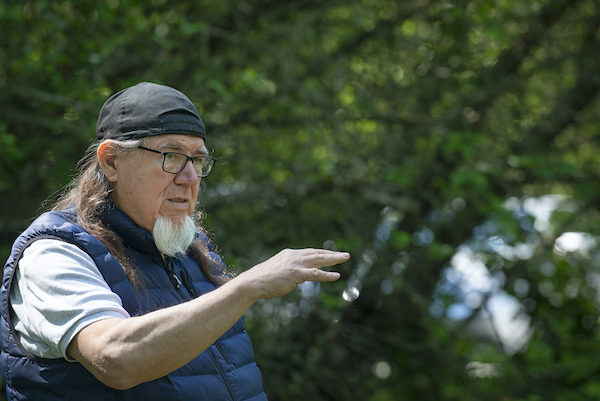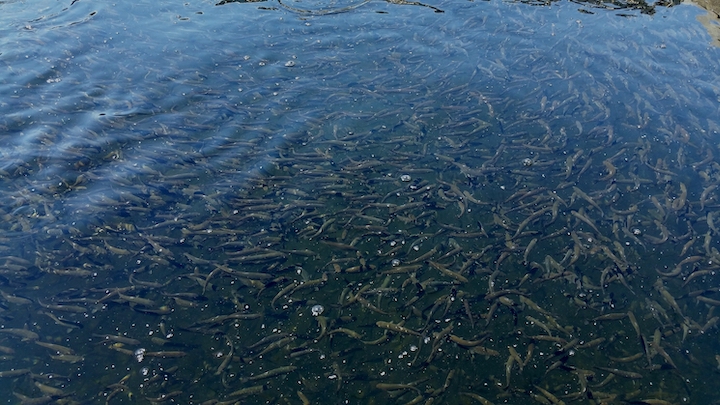
Salmon Hatcheries Needed More Than Ever: NWIFC Chair
THE FOLLOWING IS THE APRIL 2023 “BEING FRANK” COLUMN BY ED JOHNSTONE, NORTHWEST INDIAN FISHERIES COMMISSION CHAIRMAN
Salmon are a keystone species in the Pacific Northwest—a central part of the food chain and our way of life.
Throughout the region, salmon runs are imperiled by the cumulative effects of habitat degradation and a changing climate. Tribal and state co-managers are working tirelessly to keep them from going extinct, and that depends heavily on our extensive hatchery system.

In 2022, tribes released more than 39 million salmon from 24 hatcheries, 15 rearing ponds, five marine net pens and two remote site incubation facilities.
These fish provide harvest opportunities for everyone in the region. Without them, none of us would be able to fish. Hatchery fish are treaty fish. For tribes, losing the ability to harvest salmon not only deprives us of our traditional way of life, it also is a violation of the rights we reserved in treaties with the U.S. government in the 1850s.
In spite of this, hatcheries continue to be targeted by frivolous lawsuits that threaten salmon recovery and the health of the entire ecosystem. The groups behind these lawsuits misrepresent the risks of hatcheries in scientific literature while ignoring the ecological benefits. Divisive legal strategies squander our collective strengths at a time of unprecedented urgency for our region’s salmon. We should be working together to attack the causes of habitat loss and salmon predation, not one another.
We shouldn’t have to rely on hatcheries. We would rather have a properly functioning ecosystem that supports natural salmon production. But with uncertain ocean conditions and warming temperatures, we need hatcheries more than ever. They mitigate for lost spawning habitat and help preserve and recover populations listed under the Endangered Species Act.
There’s a significant misunderstanding that if we take the hatcheries away there would be a miraculous recovery of wild salmon, but this couldn’t be further from the truth. If the lawsuits were successful in shutting down our state’s hatcheries—removing this keystone species from the ecosystem—the effects would be catastrophic.
Salmon contribute to more than human sustenance and ways of life. They nourish species as small as plankton and as large as orcas. Dwindling salmon runs are thought to contribute to the poor health of southern resident orcas, and a statewide task force recommended increasing salmon hatchery production significantly to help feed the struggling killer whales.

The nutrients that adult salmon bring back from the ocean contribute to the life of the entire ecosystem in the watershed where they return. When salmon carcasses decay after spawning, insects, terrestrial birds and other mammals feed on them. Salmon recovery plans often include the distribution of carcasses from hatcheries into the watershed to help recover invertebrate populations essential for the health and survival of juvenile salmon. Even trees benefit. Numerous studies have shown increased growth in trees near rivers where salmon have died.
The tribes and our state co-manager operate hatcheries based on the latest, best available science to make sure the programs do not interfere with salmon recovery. Hatchery facilities have as minimal of an impact on the environment as possible because of how carefully they are monitored. Several NWIFC member tribes have their own water quality standards regulating discharge. Overall, the discharge released from the facilities where fish are raised is well below what is released from other operations with discharges, like wastewater treatment plants.
Right now, the majority of chinook salmon that return to our region come from hatcheries. Orcas and the multitude of other species that rely on salmon as part of their diet do not distinguish between hatchery and natural-origin fish.
If we didn’t have hatcheries, not only would tribes lose their treaty-protected rights to harvest salmon, but the ecosystem would suffer as well. We must acknowledge and protect the ecological benefits of hatchery programs as we continue salmon recovery efforts—and stand against any legal threats to curtail them.
